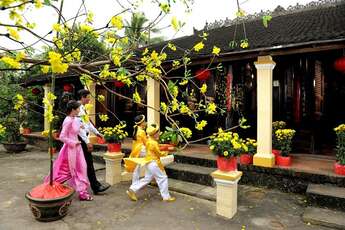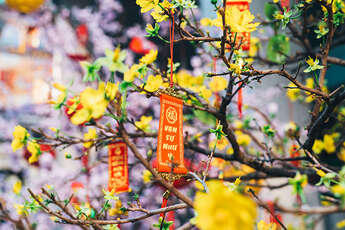
Hanoi Silk Street
- on Jan 11, 2018 By: LucyH
Silk Street – A beauty of Hanoi
The phrase “Silk Street” evokes the Silk Road has recently become an inspiration for a French in which he titled his book Rue de la Rosie (Silk Street) although it has almost nothing to do with Silk Street in Ha Noi. Perhaps, a publicity stunt, Vietnam being a little in the limelight these days. Most tourists staying at Hanoi, if asked to point out the Silk Street, would undoubtedly point to the present Hang Gai and Hang Bong where silk goods and embroidery are now sold, along with custom-tailored clothing.
The red silk Street (Hang Dao) is also a fashionable in the Old Quarter of the capital city, but nowadays it is aligned with jewelry and wristwatch shops, with some clothing stores mixed in. Literally, Hang Dao Street’s name reflected the commercial activity that took place there. As early as the 14th and 15th centuries, villagers-mostly from Dan Loan village in Hai Duong province-settled there, forming the guild of Dai Loi. At number 90 a stone stele can still be found, noting that in 1706, the edifice was built as a communal house in hour of the tutelary god of the village and patron saint of dyers.
Travel back in time
Silk Street, as indicated in the 15th century Treatise on Geography (DÆ° địa chí) by Nguyen Trai, was part of a dyke separating Ho Thai Cuc (Lake of the great primary principle), which is now completely dry, from Hoan Kiem – The restored sword lake. The two lakes used to communicate with each other through a canal, which lay on site of the present Cau Go Street, thus called in memory of the bridge that once spanned it.
In his book of poem “Vu Trung Tuy But” (Collection written on Rainy Days), the author leaves us a vivid descriptions of senses silk street and silver street where the wealth, corruption and fraud of troubled period could be seen. French attacks in 2873 and 1882 reduced the property of Silk Street, which was eventually revived toward the end of the century.Silk Revolution

The face of Silk Street has changes more than once in recent times. At the beginning of the century, its traditional features were still intact: families practiced trading silk and silk fabrics from generation to generation (the craft of dyeing having moved elsewhere, e.g., to the street of the Wooden Bridge). During this period, the street also had a high reputation for the quality of its scholars and mandarins as well as the beauty of its young women, elegant and skillful in commerce, whose plentiful dowries attracted graduates of the newly opened French University.
On both sides of a badly gravely road, about a hundred shops housed in narrow, low-roofed houses jostled each other in picturesque disorder. There was no pavement. Each shop was made up of two compartments: The outer one was fitted with a small glass-window displaying rows of young or middle-aged, had the job of touting passing customers, many of whom were from the countryside: the inner compartment featured a plank-bed, on which sat the owner of the shop or her daughter, surrounded by glass cases filled with rolls of brocade, flowered satin and silk gauze. Trading in raw silk was also a local specialty. Much haggling usually accompanied the business being done, for as a rule exorbitant prices were asked to begin with.
On every 1st, 6th, 11th, 16th, 21st and 26th days of each Lunar month, great animation came to Silk Street. People from weavers’ villages brought their products: Gauze from La Ca and La Khe and silk-floss from Dai Mo and satin from Buoi market. They also came to buy raw silk. They gave orders to dyers from Cho Dau (Dinh Bang) from areas bordering West Lake, from Buoi, from Dyers’ street (Tho Nhuom) and from Wooden Bridge Street. After the end of the First World War, Silk Street experienced a measure of modernization. Indians coming from the five French trading posts in India opened shops selling cotton fabrics distributed by French companies (Demarest, Denis Frere, etc.); others called chettys, practiced usury.
Shops selling Vietnamese silks decreased in number. Their fronts were arranged like those kept by Indians: a wide glass-window, a counter and a signboard lettered in the romanized vernacular or French instead of a curtain, on which the name of the shop was traced in Chinese characters. The first haberdashery appeared in 1917. By the 1930s Silk Street was dominated by linen-drapers’ shop also selling fancy goods from Paris: perfumes, cosmetics, hats, neckerchiefs, handkerchiefs, ties and other paraphernalia of modern times. For several decades following the liberation of Ha Noi, which was occupied by French troops from 1946 to 1954, Silk Street’s activities were muted, private trade not being encouraged.
Starting from the mid-1980s, however, with the adoption of a market economy, there has been a specular revival, with a mushrooming of watch-makers’ shops, haberdasheries, shops selling ready to –wear garments, along with ugly concrete buildings which threaten to disfigure not only Silk Street, but the entire quarter.
Comment
Other Blog
Categories
Latest News
on 27 Apr, 2023      
on 15 Apr, 2023      
on 28 Mar, 2023      
 Español
Español Français
Français



















F
on Jan 3, 2024Igor Mozetic
on Apr 8, 2023Ira Beale
on Feb 10, 2023Phạm Phú Toàn
on Jan 28, 2023Max Stover
on Jan 11, 2023